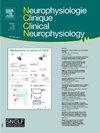Evaluating postoperative motor function using postoperative navigated transcranial magnetic stimulation motor mapping
IF 2.4
4区 医学
Q2 CLINICAL NEUROLOGY
Neurophysiologie Clinique/Clinical Neurophysiology
Pub Date : 2025-04-15
DOI:10.1016/j.neucli.2025.103072
引用次数: 0
Abstract
Objective
Navigated transcranial magnetic stimulation (nTMS) motor mapping has been established in the preoperative workflow of brain tumor patients. This study aimed to evaluate the use of postoperative nTMS motor mapping, which has been rarely performed to evaluate surgery-associated corticospinal tract injuries and functional outcome.
Methods
Patients undergoing resection of brain tumors, who received pre- and postoperative nTMS motor mapping were retrospectively evaluated. Further inclusion criteria were postoperative deterioration in motor function or the presence of a preoperative motor deficit MRC ≤3/5 without significant improvement after surgery. Postoperative nTMS was conducted within 14 days after tumor surgery. Corticospinal tracts (CST) were visualized using pre- and postoperative diffusion tensor imaging (DTI). Distances between the tumor and the CST as well as the resection cavity and the CST were measured. Primary outcome was a functionally adequate (MRC ≥4/5) motoric status after 3 months.
Results
Seventeen patients were included, mean age was 59.5 ± 14.9 years. Motor evoked potentials (MEP) of at least one extremity were recorded in 14 cases (82.4 %). The positive predictive value (PPV) for motor recovery of postoperative nTMS mapping was 90.5 %, the negative predictive value (NPV) was 38.5 %. Motor thresholds of the operated hemisphere increased significantly after surgery (p = 0.008), whereas the motor thresholds of the contralateral hemisphere remained stable (p = 0.11). Pre- and postoperative CST-visualizations did not differ concerning the distance between CST and lesion or resection cavity.
Conclusion
nTMS potentially predicts functional recovery of transient postoperative motor deficits. Further studies are warranted to prove this effect. Motor deficits significantly improved if it was possible to elicit MEPs with nTMS postoperatively.
利用术后导航经颅磁刺激运动图谱评估术后运动功能
目的建立导航经颅磁刺激(nTMS)运动定位在脑肿瘤患者术前工作流程中的应用。本研究旨在评估术后nTMS运动定位的应用,该方法很少用于评估手术相关的皮质脊髓束损伤和功能结果。方法回顾性分析脑肿瘤切除术患者术前和术后的nTMS运动图谱。进一步的纳入标准是术后运动功能恶化或术前运动缺陷MRC≤3/5,术后无明显改善。术后nTMS于肿瘤术后14天内进行。采用术前和术后弥散张量成像(DTI)观察皮质脊髓束(CST)。测量肿瘤与CST之间的距离以及切除腔与CST之间的距离。主要终点是3个月后功能充足(MRC≥4/5)的运动状态。结果纳入17例患者,平均年龄59.5±14.9岁。14例(82.4%)至少记录到一条肢体的运动诱发电位(MEP)。术后运动恢复的阳性预测值(PPV)为90.5%,阴性预测值(NPV)为38.5%。手术半球运动阈值术后明显升高(p = 0.008),而对侧半球运动阈值保持稳定(p = 0.11)。术前和术后CST图像在CST与病变或切除腔的距离上没有差异。结论ntms可预测术后短暂性运动障碍的功能恢复。需要进一步的研究来证明这种效应。如果术后用nTMS诱导mep,运动缺陷显著改善。
本文章由计算机程序翻译,如有差异,请以英文原文为准。
求助全文
约1分钟内获得全文
求助全文
来源期刊
CiteScore
5.20
自引率
3.30%
发文量
55
审稿时长
60 days
期刊介绍:
Neurophysiologie Clinique / Clinical Neurophysiology (NCCN) is the official organ of the French Society of Clinical Neurophysiology (SNCLF). This journal is published 6 times a year, and is aimed at an international readership, with articles written in English. These can take the form of original research papers, comprehensive review articles, viewpoints, short communications, technical notes, editorials or letters to the Editor. The theme is the neurophysiological investigation of central or peripheral nervous system or muscle in healthy humans or patients. The journal focuses on key areas of clinical neurophysiology: electro- or magneto-encephalography, evoked potentials of all modalities, electroneuromyography, sleep, pain, posture, balance, motor control, autonomic nervous system, cognition, invasive and non-invasive neuromodulation, signal processing, bio-engineering, functional imaging.

 求助内容:
求助内容: 应助结果提醒方式:
应助结果提醒方式:


